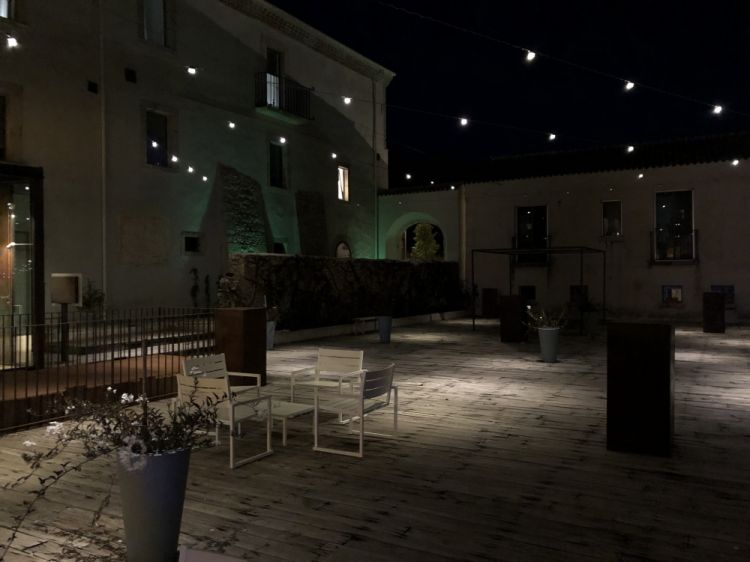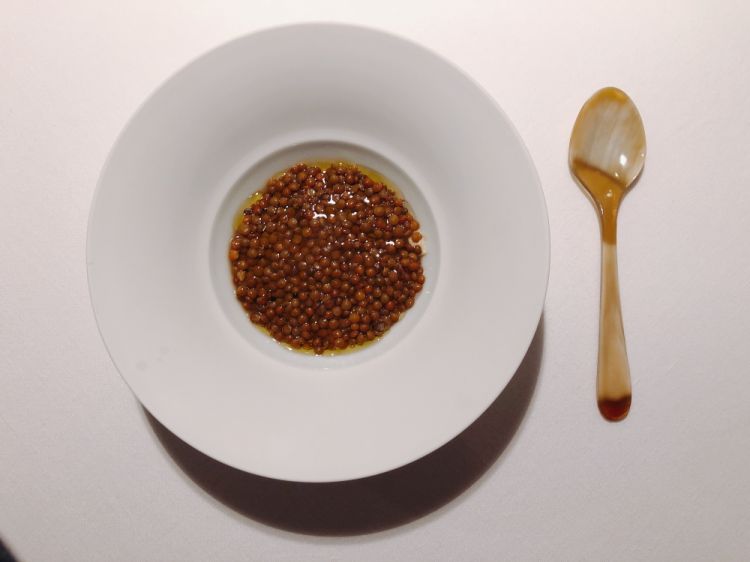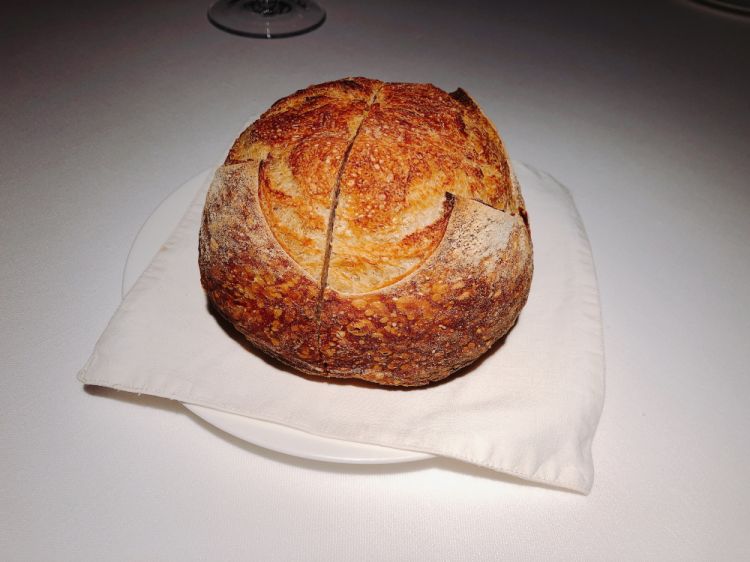The air in Castel Di Sangro is full of inspiration, concreteness and beauty, perhaps today more than ever before. When you enter Casadonna past the mighty entrance arch, on the left you are immediately struck by a wall of roses in bloom, even in autumn, thanks to the unusually mild climate dictated by these new times. It is the power of plants, so strong and vigorous that it makes a wall bloom. Who knows if Cristiana and Niko Romito grasped this nuance before deciding to propose an all-vegetable menu at restaurant Reale, the fruit of the experience accumulated over time and the summa of countless individual vegetable touches, scattered here and there over the years, between the à la carte and the tasting menu.

A view of Reale Casadonna
recounts, with great serenity: ‘I feel I can say this path combines maturity, which I felt I had reached, with the future, which is represented by the vegetable world, in all its facets. We worked a lot with the kitchen team to extract new notes from each ingredient, always respecting the raw material. Another important aspect is that vegetables arouse a lot of curiosity, especially among young people, who have started to visit
Reale more. This is no coincidence. I noticed that, in recent years, the most talked-about dishes in my kitchen were precisely those without animal protein... And we decided to take the plunge'.

The inner courtyard of Reale Casadonna at night
It must be said that, in the à la carte choices, a few meat or fish dishes have remained, to give further freedom of choice and to keep some of the chef from Abruzzo classics alive (
Pigeon fondant and pistachio,
Cold duck and smoked duck water,
Trout, almond and bay leaf, to name but a few).
The experience at Reale is always absolutely enthralling, with almost mystical contours, thanks to the place where it takes place, that beautiful former monastery nestled in the foothills of the Val di Sangro.
The setting, therefore, already prepares one to internalise and savour Niko Romito's philosophy, with a dining room brigade that narrates the dishes with the right mix of poetry and science, leaving the final discovery to the guest. Cristiana Romito is an increasingly important figure for the group of very young waiters, handing out contagious smiles and moving around the room bringing a touch of colour, in contrast with the customary blue liveries. One perceives a deep participation and union between dining room and kitchen: they explain dishes with the enthusiasm of someone who has witnessed their creation.

The wall at the entrance, blooming with red roses
The same passion burns in
Gianni Sinesi, for many years now the head sommelier at
Reale. He has succeeded in designing a course by the glass, not only of wines, but also following a desire to dare. Particularly successful are the pairings with
Sliced Mushroom (
Madeira Justino's 2005) and
Red Onion, Montepulciano and Bread (
Banyuls Domaine Du Duy 1983), which natural amplify the scents found in the dishes, especially through contrast.
As a commercial from the nineties used to say, "Power is nothing without control" and Niko Romito (in concert with Dino Como, his historic sous-chef) knows this well, since the dishes are indeed bold and absolute in their peaks of taste, but they reflect a great cuisine that is reasoned, experimented, unique and unmistakable in its cleanliness, style and depth. Seeing, tasting and internalising them, it is as if one immediately realises that Romito's hand is behind these edible creations, not least because of the colours and the layouts, without frills, but with a naked elegance that enraptures the eye.

Niko Romito and Dino Como
The raw materials used live again and again, as if they had reincarnations in themselves: for example, the
Cauliflower au gratin sees the vegetable used in different maturations and textures, so that you think that there is something else in the dish, even though there is not. Then there is the
broccoli leaf, in which the
broccoli flowers make up the glaze, to which aniseed is added, giving a granitic palatal structure to what would appear to be 'only' a very thin sheet of chlorophyll. It releases an unprecedented umami, which lingers long, as in the
Alcoholic Lettuce with Cream of Milk: here the
Monkey 47 gin fulfils the task of a taste catalyst, giving an aromatic thrust that nicely combines the herbaceous with the lactic.
This menu shows continuous movement, often with bitterness as a common thread, tamed by other ingredients, such as toasted fatness in Radicchio and peanuts or fragrances, like the heady one of roasted potatoes with rosemary that emanates from Scarola. The great Italian tradition cannot fail to include fresh pasta, declined by Chef Romito in two dishes. Tagliatelle with Parmigiano and lemon are intended to be the only "comfort" dish proposed, to break that deep rhythm and give a memory that tastes of home, while Tortelli with pumpkin are, in fact, a pre-dessert in which the sweetness of the cucurbit dominates, with no other added elements except water (another ingredient now fundamental at Reale), with which the sauce that completes the dish is "pulled".

Gianni Sinesi, sommelier at Reale
In spite of all these different, almost kaleidoscopic impulses, one constant remains: the profound analysis that accompanies the birth of a
Niko Romito dish, from the ingredient, to the recipe, to the appearance, even in a meatless and fishless context.
This time the 'invisible engine' of everything is plant power, so powerful that it is capable of making a wall bloom with roses.

Celery, carrot and onion: it may resemble a vegetable broth, but there is no water inside. It is a double extraction of these three vegetables with raw oil and sage. Small caution: the wine is served afterwards, to allow it to be tasted purely, with immaculate taste buds

Broccoli leaf and aniseed: the leaf is blanched in water and salt, to bring out more colour and flavour, while the glaze is given by the broccoli flower, with drops of aniseed. An dish that represents Niko Romito's vegetable turn, it has now become a natural icon

First part of the leavened products: breadsticks with chestnut honey and solina flour and moist pizza with saragolla flour. Cristiana Romito explains: 'Moist because the dough is quite wet. It is prepared like polenta, with large amounts of water'.

Potato soup: two types of potatoes are used, both from Fucino. With the Agria potato, a broth is prepared under pressure, with herbs and spices, which is filtered in a quick passage with smoked black tea. With the red potato (drier), a creamy potato soup is prepared, julienne potatoes and a potato peel powder. Lemon, in juice and zest, completes the dish

Lentils, hazelnut and garlic: at the base is a lentil jelly (derived from their cooking water), in the middle a hazelnut emulsion and on top the Santo Stefano di Sessanio lentils, small and crunchy. The dish plays on the three textures, to be savoured together, drawing the spoon from bottom to top

Bread: an iconic course, which still remains on the tasting menu to emphasise its centrality and importance. It is made with white flour, sourdough and potatoes, with a crispy crust and soft, creamy interior

Alcoholic lettuce and milk cream: the lettuce is marinated in brine to fix its colour and structure, then glazed with lettuce reduction and a few drops of Monkey 47 gin as a vegetable note enhancer (this gin, with 47 botanicals, does this task excellently). At the base is a milk cream. If eaten all in one mouthful, there is a deflagration of flavour, with bitterness and lacticity balancing out in a persistent and pleasant length on the palate

Sliced porcini mushrooms: this is made from 100 per cent porcini mushrooms. They are creamed at the base and then sliced on top. To close, a fermented mushroom extract. It is the total representation of the porcini mushroom concept

Trout, almond and bay leaf (off-track, not included in the vegetable course): the idea is to do a great job on the structure of the trout. It is usually a tender fish, but in this case you want to emphasise its meatiness. It is placed in a net, like a sausage, and left to dry for two or three days, then cooked in the oven. Completing the dish is a cream of blended almonds, a trout base and a bay leaf extract, with powerful balsamic and bitter notes. The dish develops on a play of contrasts between the bay leaf and the sweetness of the fish and almonds

Cauliflower gratin: a great Niko Romito classic. It is steamed and then rests for 5 to 7 days, ripening naturally. They are then blended and water is extracted from them and brought to a reduction, which is then used to lacquer the cauliflower after the gratin. At the base is a cauliflower cream, made from the raw ingredient cut with a knife and stewed. Same element, multiple layers: it is the reincarnation of an ingredient

Red onion, Montepulciano and bread: the result is the recovery of a traditional recipe. Stale bread soaked in red onion water and then dried in the oven, almost to caramelisation. There is then a second step in which the bread is re-soaked in a red onion reduction, with an even more intense flavour, with the addition of pure Montepulciano and drops of sage and herbs in extraction

Tagliatelle, Parmigiano and lemon: it sounds simple, but the sauce is made without any added fat, working the Parmigiano with water, to maintain a lightness that enhances the pasta, hand-rolled on wood. Complete with lemon zest, to give fragrance

Radicchio and peanuts: at the base are peanuts in two textures, i.e. as a paste and as water. On top there’s radicchio, cooked for many hours in foil, so it acquires a tender texture. Here too there is a lot of play on the contrasts between bitterness and fat, in a winning involvement

Roasted escarole: it is marinated in potato water, then battered in the same potato water and cooked at a high temperature. At the base, a cream of escarole. The deviation between aromas and flavours is crazy: the aroma of the roasted potatoes is very noticeable on the nose, but the bite then betrays the true identity of the dish, namely the escarole, bitter and firm

Pumpkin tortelli: this is one of the symbols of fresh Italian stuffed pasta, seen through Niko Romito's eyes, i.e. as an unusual predessert that plays on the natural sweetness of the pumpkin. Two types of pumpkin are used: the (more watery) Violina for the creamy base, the (sweeter) Piacentina for the filling

Walnuts and Clementines: a dessert without added sugar, as Niko Romito has been proposing for years, which is based on the prized Lara walnut from Treviso. It consists of a walnut paste with bay leaf extraction and grated walnut, while at the base there is clementine juice, a clementine sauce and stewed clementines

The conclusion: winter melon, grapes, chocolate discs, lemon infusion
Translated into English by Slawka G. Scarso